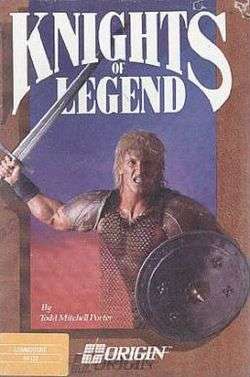Knights of Legend
 | |
| Developer(s) | Todd Porter |
|---|---|
| Publisher(s) | Origin Systems |
| Designer(s) | Todd Porter |
| Platform(s) | DOS, Apple II, Commodore 64 |
| Release date(s) | October 1989 |
| Genre(s) | Role-playing video game |
| Mode(s) | Single-player |
Knights of Legend, released by Origin Systems in 1989, is a role-playing video game.
Story
The game is set in the fictional land of Ashtalarea, where the evil Pildar has imprisoned the Duke, the ruler of the land, and Seggallion, a knight who had stopped Pildar in the past. The player leads a band of adventurers who try to free the prisoners and stop Pildar.
Gameplay
The game is a standard role-play game, with the classic races of dwarves, elves and humans available for players to make up their party of adventurers. The game also adds a novel race called the "Keldar", which had the power of flight. Quest-givers in various towns direct players to areas of the larger world map, which lead to premade map sites where an item is set to be retrieved to complete the mission.
Each quest site map has a tactical feel similar to later RPGs and the Jagged Alliance series: visibility is limited to what each character can actually see, and this visibility increases with flying characters.
Additionally, combat incorporates the concept of extensive use of fatigue. Each combat round comprises planning thrusts, parrys and jumps, sometimes in anticipation of the opponent's choices which are revealed through the "foresight" attribute.
The game has a save-game feature wherein games can only be saved by resting at an inn; this often makes for very long play sessions.
The game had support to add region and adventure modules, which were supposed to be released starting in 1990. However, no modules were released due to Todd Mitchell Porter leaving Origin and taking the rights to Knights of Legend with him.
Reception
The game was reviewed in 1990 in Dragon #155 by Hartley, Patricia, and Kirk Lesser in "The Role of Computers" column. The reviewers normally gave a game a rating from 1 to 5 stars, but they gave the Apple II version of this game an "X" for "Not recommended".[1] The Lessers reviewed the PC/MS-DOS version of the game in Dragon #157, and gave that version of the game 5 out of 5 stars.[2] Scorpia of Computer Gaming World in 1991 and 1993 called it "tactical wargaming with a thin veneer of role-playing". The magazine stated that the constant combat became "tedious", and only recommended it for "wargamers or devoted hack'n'slashers".[3][4]
References
- ↑ Lesser, Hartley; Lesser, Patricia; Lesser, Kirk (March 1990). "The Role of Computers". Dragon (155): 95–101.
- ↑ Lesser, Hartley; Lesser, Patricia; Lesser, Kirk (May 1990). "The Role of Computers". Dragon (157): 96–103.
- ↑ Scorpia (October 1991). "C*R*P*G*S / Computer Role-Playing Game Survey". Computer Gaming World. p. 16. Retrieved 18 November 2013.
- ↑ Scorpia (October 1993). "Scorpia's Magic Scroll Of Games". Computer Gaming World. pp. 34–50. Retrieved 25 March 2016.
External links
- Knights of Legend at MobyGames
- Knights of Legend can be played for free in the browser at the Internet Archive
- Pictures of the box and inside materials